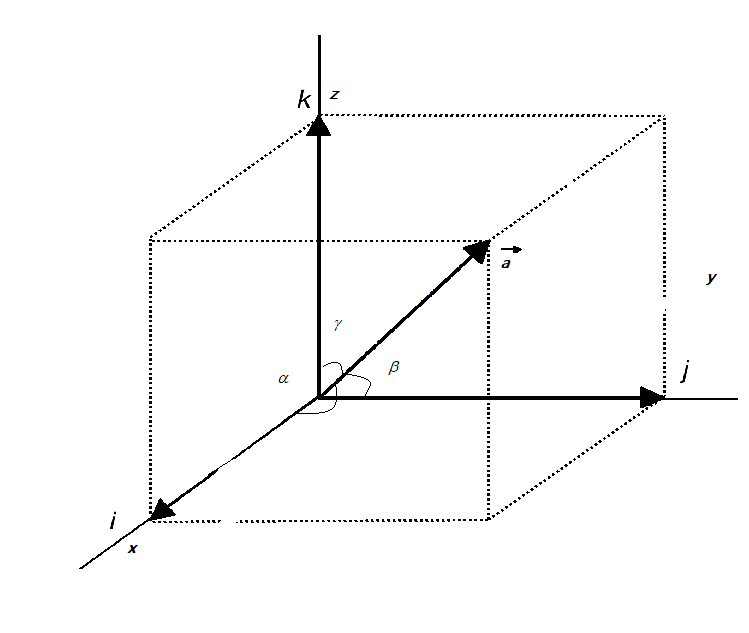
If a vector $\overrightarrow{A}$ makes angles $\alpha,\beta$ and $\gamma$ with $X$,$Y$ and $Z$ axes respectively then $sin^{2}\alpha+sin^{2}\beta+sin^{2}\gamma=$
\[\begin{align}
& A.0 \\
& B.1 \\
& C.2 \\
& D.3 \\
\end{align}\]
Answer
539.4k+ views
Hint: We know that a vector has both length or magnitude and direction. The angle the vector makes with the axis give the direction or the orientation of the vector on any given space. Generally, a vector is said to make $\alpha,\beta$ and $\gamma$ with $X$,$Y$ and $Z$ axes respectively.
Complete step by step answer:
Given that the vector $\overrightarrow{A}$ makes angles $\alpha,\beta$ and $\gamma$with $X$,$Y$ and $Z$ axes respectively. This implies that the unit vector $\hat{a}$, also known as the directional vector is as shown in the figure. Then we can express the vector $\overrightarrow{A}$ as $\vec A=a_{x}\hat i+a_{y}\hat j+a_{z}\hat k$, and the unit vector $\hat{a}$ is given as, $\hat a=\sqrt{a_{x}^{2}+a_{y}^{2}+a_{z}^{2}}$

We can then express, the x,y,z components of the vectors with respect to the angles as the following:
$cos\alpha=\dfrac{a_{x}\hat i}{\hat a}$
$cos\beta=\dfrac{a_{y}\hat j}{\hat a}$
$cos\gamma=\dfrac{a_{z}\hat k}{\hat a}$
Squaring and adding, we get, $cos^{2}\alpha+cos^{2}\beta+cos^{2}\gamma=\dfrac{a_{x}^{2}+a_{y}^{2}+a_{z}^{2}}{\left(\sqrt{a_{x}^{2}+a_{y}^{2}+a_{z}^{2}}\right)^{2}}=1$
Thus, $cos^{2}\alpha+cos^{2}\beta+cos^{2}\gamma=1$
But we need $sin^{2}\alpha+sin^{2}\beta+sin^{2}\gamma$
We know from trigonometry identities, that $sin^{2}\theta+cos^{2}\theta=1$
Then, we can write, $cos^{2}\alpha+cos^{2}\beta+cos^{2}\gamma=1-sin^{2}\alpha+1-sin^{2}\beta+1-sin^{2}\gamma=3-(sin^{2}\alpha+sin^{2}\beta+sin^{2}\gamma)$
Then,$3-(sin^{2}\alpha+sin^{2}\beta+sin^{2}\gamma)=1$
Or,$sin^{2}\alpha+sin^{2}\beta+sin^{2}\gamma=3-1=2$
Thus, $sin^{2}\alpha+sin^{2}\beta+sin^{2}\gamma=2$
Hence C.$2$ is the answer.
Additional information:
We know that two vectors can be added, subtracted, and multiplied. We also know that the algebraic laws such as commutativity, associativity and distributivity are valid to certain degree and not always applicable. If a scalar and a vector is multiplied, it is said to be scalar multiplication or dot product. If a vector and another vector are multiplied, then it is said to be cross product or vector multiplication.
Note: When we say a $\vec{AB}$, we mean that $A$ is carried to $B$ in a particular direction in the space. Also magnitude denoted as $|\vec{AB}|$ gives the distance between the points $A$ and $B$. these vectors are generally represented on the coordinate systems.
Complete step by step answer:
Given that the vector $\overrightarrow{A}$ makes angles $\alpha,\beta$ and $\gamma$with $X$,$Y$ and $Z$ axes respectively. This implies that the unit vector $\hat{a}$, also known as the directional vector is as shown in the figure. Then we can express the vector $\overrightarrow{A}$ as $\vec A=a_{x}\hat i+a_{y}\hat j+a_{z}\hat k$, and the unit vector $\hat{a}$ is given as, $\hat a=\sqrt{a_{x}^{2}+a_{y}^{2}+a_{z}^{2}}$

We can then express, the x,y,z components of the vectors with respect to the angles as the following:
$cos\alpha=\dfrac{a_{x}\hat i}{\hat a}$
$cos\beta=\dfrac{a_{y}\hat j}{\hat a}$
$cos\gamma=\dfrac{a_{z}\hat k}{\hat a}$
Squaring and adding, we get, $cos^{2}\alpha+cos^{2}\beta+cos^{2}\gamma=\dfrac{a_{x}^{2}+a_{y}^{2}+a_{z}^{2}}{\left(\sqrt{a_{x}^{2}+a_{y}^{2}+a_{z}^{2}}\right)^{2}}=1$
Thus, $cos^{2}\alpha+cos^{2}\beta+cos^{2}\gamma=1$
But we need $sin^{2}\alpha+sin^{2}\beta+sin^{2}\gamma$
We know from trigonometry identities, that $sin^{2}\theta+cos^{2}\theta=1$
Then, we can write, $cos^{2}\alpha+cos^{2}\beta+cos^{2}\gamma=1-sin^{2}\alpha+1-sin^{2}\beta+1-sin^{2}\gamma=3-(sin^{2}\alpha+sin^{2}\beta+sin^{2}\gamma)$
Then,$3-(sin^{2}\alpha+sin^{2}\beta+sin^{2}\gamma)=1$
Or,$sin^{2}\alpha+sin^{2}\beta+sin^{2}\gamma=3-1=2$
Thus, $sin^{2}\alpha+sin^{2}\beta+sin^{2}\gamma=2$
Hence C.$2$ is the answer.
Additional information:
We know that two vectors can be added, subtracted, and multiplied. We also know that the algebraic laws such as commutativity, associativity and distributivity are valid to certain degree and not always applicable. If a scalar and a vector is multiplied, it is said to be scalar multiplication or dot product. If a vector and another vector are multiplied, then it is said to be cross product or vector multiplication.
Note: When we say a $\vec{AB}$, we mean that $A$ is carried to $B$ in a particular direction in the space. Also magnitude denoted as $|\vec{AB}|$ gives the distance between the points $A$ and $B$. these vectors are generally represented on the coordinate systems.
Recently Updated Pages
Why are manures considered better than fertilizers class 11 biology CBSE

Find the coordinates of the midpoint of the line segment class 11 maths CBSE

Distinguish between static friction limiting friction class 11 physics CBSE

The Chairman of the constituent Assembly was A Jawaharlal class 11 social science CBSE

The first National Commission on Labour NCL submitted class 11 social science CBSE

Number of all subshell of n + l 7 is A 4 B 5 C 6 D class 11 chemistry CBSE

Trending doubts
What is meant by exothermic and endothermic reactions class 11 chemistry CBSE

1 Quintal is equal to a 110 kg b 10 kg c 100kg d 1000 class 11 physics CBSE

What are Quantum numbers Explain the quantum number class 11 chemistry CBSE

What is periodicity class 11 chemistry CBSE

What is a periderm How does periderm formation take class 11 biology CBSE

Mention the basic forces in nature class 11 physics CBSE




